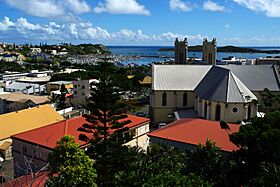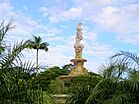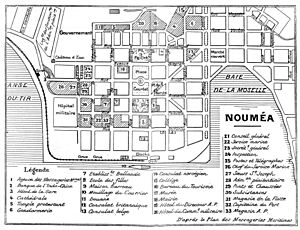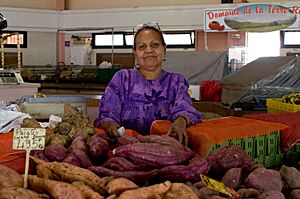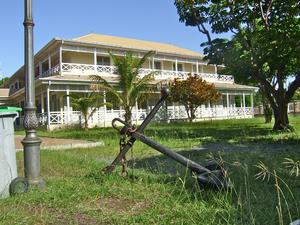Nouméa facts for kids
Quick facts for kids
Nouméa
|
||
|---|---|---|
|
Top: View of Nouméa; Middle: Nouméa Cathedral, Nouméa beach; Bottom: Nouméa City Museum, Céleste fountain
|
||
|
||
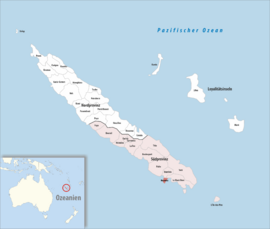
Location of the commune (in red)
within New Caledonia |
||
| Country | France | |
| Sui generis collectivity | New Caledonia | |
| Province | South Province (provincial seat) |
|
| Area
1
|
45.7 km2 (17.6 sq mi) | |
| • Urban | 1,643 km2 (634 sq mi) | |
| Population
(2019 census)
|
94,285 | |
| • Density | 2,063.1/km2 (5,343/sq mi) | |
| • Urban | 182,341 | |
| • Urban density | 110.98/km2 (287.44/sq mi) | |
| Ethnic distribution | ||
| • 2019 census | Europeans 39.15% Kanaks 26.62% Wallisians and Futunans 6.1% Mixed 10.22% Other 17.9% |
|
| Time zone | UTC+11:00 | |
| INSEE/Postal code |
98818 /98800
|
|
| Elevation | 0–167 m (0–548 ft) (avg. 20 m or 66 ft) |
|
| 1 New Caledonia Land Register (DITTT) data, which exclude lakes and ponds larger than 1 km² (0.386 sq mi or 247 acres) as well as the estuaries of rivers. | ||
Nouméa is the capital and largest city of New Caledonia. New Caledonia is a special French territory in the Pacific Ocean. Nouméa is the biggest French-speaking city in this part of the world.
The city is located on a peninsula in the south of New Caledonia's main island, called Grande Terre. Many different groups of people live here. These include Europeans, Polynesians (from places like Wallis and Futuna, and Tahiti), Indonesians, and Vietnamese. You'll also find many Melanesians and Kanaks, who are the original people of New Caledonia. Nouméa is one of the most industrial cities in the South Pacific.
Nouméa has a safe, deepwater harbor. This harbor is the main port for all of New Caledonia. In 2019, about 182,341 people lived in the larger Nouméa area. Around 94,285 of them lived in the city of Nouméa itself. Most of New Caledonia's population lives in this greater Nouméa area. This area includes the towns of Nouméa, Le Mont-Dore, Dumbéa, and Païta.
Contents
Exploring Nouméa's Past
The first European to settle near Nouméa was a British trader named James Paddon in 1851. Three years later, in 1854, the French decided to take control of the island. They set up their own settlement nearby. They moved from a place called Balade, which was in the north of the island.
This new settlement was first named Port-de-France. But in 1866, its name was changed to Nouméa. The area was first used as a penal colony. This means it was a place where criminals were sent to live and work. Later, it became important for exporting nickel and gold, which were mined nearby.
From 1904 to 1940, a railway line connected Nouméa to Dumbéa and Païta. This was the only railway line New Caledonia ever had!
During World War II, the United States military used Nouméa as its main base in the South Pacific. After the war, the large building where the US military had its headquarters became the home of a new organization. This group was called the South Pacific Commission. It now helps different countries in the Pacific work together.
Even today, you can still see the influence of the United States from the war. Many New Caledonians feel friendly towards the US because of the American soldiers they met. Also, some neighborhoods in Nouméa have English names. For example, "Receiving," "Robinson," and "Motor Pool" sound a bit strange. But they make sense when you know their history!
Where is Nouméa Located?
Nouméa is on a peninsula that has many hills. It's located near the southeast end of New Caledonia. New Caledonia is an island group in the southwest Pacific Ocean.
Here are some of the neighborhoods you can find in Nouméa:
- Rivière-Salée
- 6e km, 7e km, Normandie, and Tina
- Ducos peninsula, which includes:
- Ducos, Ducos industriel, Kaméré, Koumourou, Logicoop, Numbo, Tindu
- 4e Km, Aérodrome, Haut Magenta, Magenta, Ouémo, and Portes de fer
- Faubourg Blanchot and Vallée des Colons
- Doniambo, Montagne coupée, Montravel, and Vallée du tir
- Artillerie Nord, Centre Ville, Nouville, Quartier Latin, Vallée du Génie
- Anse Vata, Artillerie Sud, Baie des Citrons, Motor Pool, N'géa, Orphelinat, Receiving, Trianon, and Val Plaisance
Nouméa's Climate
Nouméa has a tropical savanna climate. This means it has hot summers and warm winters. The warmest months are January, February, and March. During these months, the average high temperature is around 30 degrees Celsius. The cooler months are July and August, with average highs around 23 degrees Celsius.
The driest months in Nouméa are September and October. The rest of the year usually has more rain. On average, Nouméa gets about 1,100 millimeters of rain each year.
Who Lives in Nouméa?
In 2019, the greater Nouméa area had a total population of 182,341 people. Of these, 94,285 lived in the city of Nouméa itself.
The greater Nouméa area is made up of four different towns:
- Nouméa (94,285 people)
- Dumbéa (35,873 people), located northwest of Nouméa
- Le Mont-Dore (27,620 people), located northeast of Nouméa
- Païta (24,563 people), a town west of Dumbéa where the international airport is located
Population Changes Over Time
The population of Nouméa and the greater Nouméa area has grown a lot over the years. Here's a look at how the numbers have changed:
|
|
||||||||||||||||||||||||||||||||||||||||||||||||||||||||||||||||||||||||||||||
Where People Come From
In 2014, most people living in the greater Nouméa area (66.7%) were born in New Caledonia.
- About 21.2% came from Metropolitan France or other French territories outside the Pacific.
- Around 6.3% were born in foreign countries like Indonesia, Vanuatu, Vietnam, and Algeria.
- Another 5.8% came from France's other Pacific territories, mainly Wallis and Futuna and French Polynesia.
Different Cultures and Groups
In 2019, people in the greater Nouméa area identified with different ethnic groups:
- 30.65% were Europeans.
- 26.36% were Kanaks, the original people of New Caledonia.
- 11.66% were from Wallis and Futuna.
- 12.59% identified as having a mixed ethnicity.
- 18.75% belonged to other communities. This group includes some White people who chose not to identify as "Europeans."
Languages Spoken
In 2009, almost everyone (98.7%) aged 15 and older in the greater Nouméa area could speak French. Most of them (97.1%) could also read and write it. Only a very small number (1.3%) did not know French at all.
At the same time, about 20.8% of people aged 15 and older could speak at least one of the Kanak languages. These are the traditional languages of New Caledonia. A smaller group (4.3%) could understand a Kanak language but not speak it. Most people (74.9%) did not know any Kanak language.
Nouméa's Economy
Nouméa is becoming a more modern city. Even though it's not a huge tourist spot yet, there has been a lot of new building in the 21st century. The city has also added many new facilities and services. The local government is working on public projects to improve the city.
The mayor of Nouméa is Sonia Lagarde. She was re-elected in 2020.
Getting Around Nouméa
Aircalin is the international airline of New Caledonia. Air Calédonie (Aircal) is the domestic airline, which flies within New Caledonia. Both airlines have their main offices in Nouméa. Aircal's office is at Nouméa Magenta Airport, which is used for local flights.
Nouméa's international airport is La Tontouta International Airport. It is about 50 kilometers (31 miles) away from the city.
The Nouméa-Païta railway was the only railway line in New Caledonia. It stopped running in 1940.
Learning and Culture in Nouméa
The University of New Caledonia (UNC) is an important place for learning. It started in 1987 as part of a larger French university in the Pacific. In 1999, it became its own separate university.
Every year, about 3,000 students from New Caledonia and other countries study at UNC. There are also about 100 professors and researchers.
The Bibliothèque Bernheim (Bernheim Library) is also located in Nouméa. It's a great place to find books and learn.
The city also has several museums. One of them is the Maritime Museum of New Caledonia, which tells the story of the sea and ships.
Nouméa's Sister Cities
Nouméa has "sister city" relationships with other cities around the world. This means they share cultural ties and friendly connections.
 Gold Coast, Australia
Gold Coast, Australia Nice, France
Nice, France Papeete, French Polynesia
Papeete, French Polynesia Taupō, New Zealand
Taupō, New Zealand
Famous People from Nouméa
- Marianne Devaux - A politician
- Ilaïsaane Lauouvéa - A politician
- Gilles Pisier - A mathematician
- Peato Mauvaka - A rugby union player
Images for kids
See also
 In Spanish: Numea para niños
In Spanish: Numea para niños


